“What is a Good Company Culture”
This is one of the top Google searches when it comes to culture. What I find interesting are the results.
When you search for “What is a Good Company Culture” you will find definitions, examples, and Top 10 lists of signs and elements of a good culture. What you don’t find is a model of what a good company culture looks like.
One of my favorite signs of a good company culture I read recently is “your company’s parking lot is devoid of trash”. I like this one because it reminds me of a tarot card reading: sort of interesting but not very useful.
To be fair, I can see how employees taking time to throw away their trash is a sign of caring; but I don’t see how this information is useful to executives or senior leaders. It’s not useful because it’s not actionable. It may be relevant, it may be insightful, but from a leadership perspective, there’s nothing they can do with the information to make a positive impact on company culture or drive performance.

That’s the strength of a model. A model provides a framework executives and senior leaders can use to monitor, measure, and drive results. Models are a pathway to ROI and Return on Culture.
At The Culture Think Tank (CTT), our Culture Model was developed to provide executives and senior leaders a framework they can use to measure the strength of their company’s culture, align their culture to support the objectives and purpose of the company, and proactively improve their company’s culture and performance.
A Model of a Good Company Culture
The model is founded on three simple principles:
- Measurability
- Actionability
- Impact
From our perspective at The Culture Think Tank, a successful model is a model that drives performance and delivers return. As a result, for a model on culture to be effective in today’s work environment, the drivers of culture have to be easy to measure, easy to implement, and deliver results. This is why the CTT Culture Model begins with feelings.
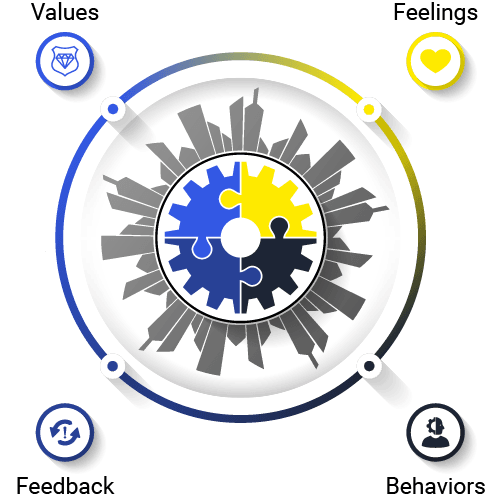
The CTT Culture Model is supported by five years of research, over 2,500
Interviews with executives and senior leaders, and two research surveys.
Why Feelings Matter
Feelings are how a workforce measures culture. It’s how they communicate. If you ask an employee what they like about their company’s culture, their answer is going to be a feeling.
- I like the teamwork
- I like the sense of family
- I like how I’m challenged
- I like the opportunities for promotion
There is really no way to understand or measure a company’s culture without involving the workforce, which means, to measure culture, you have to begin by measuring feelings.
Beyond providing a measurement or metric of culture, feelings are important because feelings impact performance.
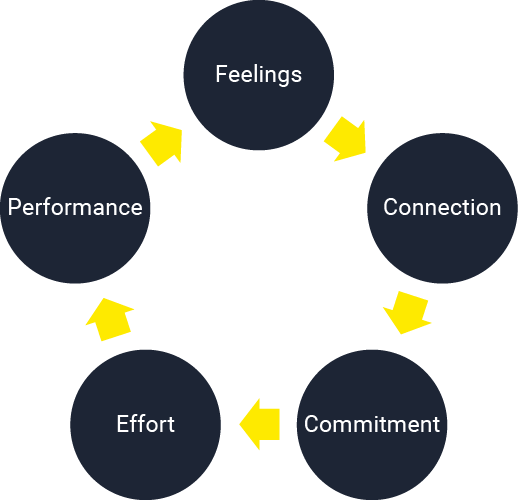
How employees feel about their company impacts how connected they are to the company. Employees' sense of connection impacts commitment, which impacts effort, which ultimately drives performance.
This is why feelings matter. Feelings provide a mechanism to measure the sense of connection employees have to the company, which provides a metric to monitor and track the strength of a company’s culture. The greater the sense of connection the stronger the culture.
Feelings Aren’t Enough
Although feelings provide a means to measure culture, they don’t provide a means to improve culture. It’s hard for executives and leaders to take action based upon their employees' feelings. To take action, you have to understand the cause of employees' feelings. You have to know what to do.
Behaviors, particularly leadership behaviors, provide the executives and senior leaders the means to understand the cause of employees’ feelings and the insights they need to positively impact how employees feel.
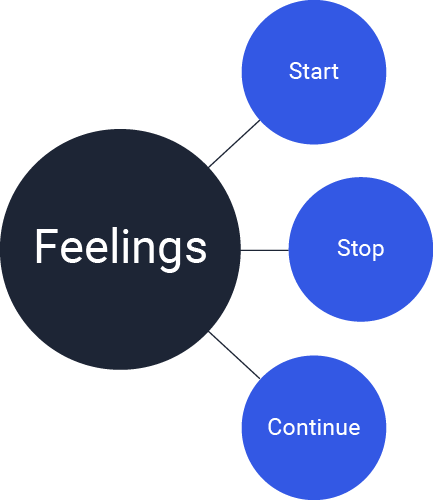
Three metrics are the keys to connecting feelings to actionable behaviors that impact culture. The metrics are the behaviors leaders need to Start, Continue, and Stop doing.
By correlating feelings to behaviors, the model is able to translate the employees’ feelings that are impacting their sense of connection to the company and ultimately impacting their performance to leadership behaviors.
This correlation provides leaders the ability to understand how their actions are impacting culture and the steps they can take to improve culture and performance.
By asking the workforce how they feel about the company’s culture and what they need their leaders to Start, Continue, and Stop doing, executives and senior leaders can easily identify the actions they need to take to respond to and impact how their workforce feels. Feelings, as we mentioned earlier, impact employees’ sense of connection to the company, which impacts commitment, effort, and performance.
Feedback Is the Key to Positive Change
Although the correlation between feelings and behaviors provides the insights leaders need to impact their company’s culture and drive performance, a company’s culture will not change if executives and senior leaders don’t take action. You have to implement what you learned to make a difference.
The easiest and most effective way to implement a change in behaviors is to provide feedback. The simple act of sharing the results of what you learned with the entire organization, from executive leadership down to frontline staff, will help drive positive change. Peter Drucker is credited with the quote
“What gets measured gets managed. What gets managed gets improved.”
Sharing what you learned is an essential step. When a workforce knows and understands their leaders are listening to them and taking action based upon their input, they buy-in. Implementing positive change is possible when you have buy-in.
Aligning Values Enhances Impact
The final aspect of the CTT Culture Model is values. Most companies have defined their purpose and values. Values are the actions or beliefs that help a company fulfill their purpose. Within the Good Company Culture Model, values are the bridge between a company’s culture and purpose.
The bridge is constructed by matching the behaviors your workforce desires your leaders to Start and Continue doing to the values of the company. What many executives and senior leaders find is there are gaps or lack of alignment.
This is not a bad thing. What the gaps identify are opportunities where the values of the company may need to be adjusted, clarified, or, in some cases, changed. Changing the values of the company does not mean the purpose of the company changes. It just means the way in which the company fulfills its purpose is not fully reflected in its values.
A good culture that drive performance is one in which the purpose, values, behaviors, and feelings align. Market and economic conditions change overtime. Keeping the values aligned to the behaviors that drive performance, is the key to growing and sustaining a good culture.
Improving Culture Takes Perpetual Effort
Although values are the last aspect of the model, there is a reason the center of the CTT Culture Model is shaped as a cog or gear: repetition matters. For a company to achieve and sustain a good company culture, the model has to be perpetually repeated.
It is not something that has to be done every week or month but is something that needs to be done at least four times a year. Unless executives and senior leaders commit to a perpetual effort, their company’s culture will slide to the status quo and the efforts they put in will be lost.
The Nash Equilibrium provides a good way to depict the slide to the status quo. Culture growth occurs when leaders build new habits based on the behaviors the workforce needs leaders to Start, Continue, and Stop doing.
Feedback and encouragement are needed to help leaders succeed in building new habits. Knowing when to offer feedback and encouragement requires monitoring their efforts. This is the formula for positive change.
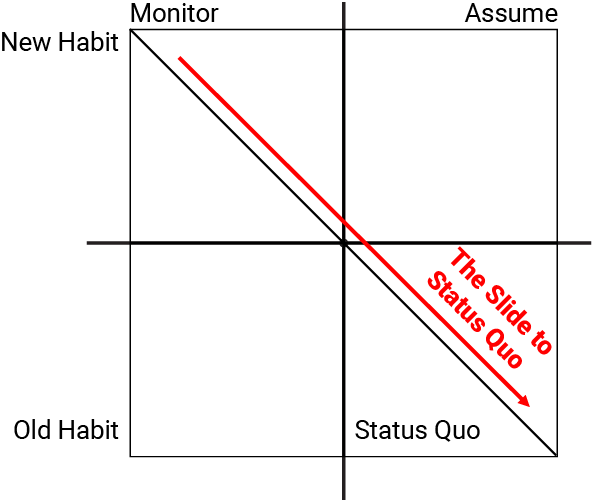
As soon as active interest stops and assumptions kick in, leaders will revert back to their old habits and the company’s culture will slide back to the status quo.
Getting Started
The CTT Culture Model is easy to implement. Getting started is as simple as asking your workforce four questions.
- From a work and life perspective, how are you feeling right now in ONE word?
- What is the one thing you wish your boss would START doing to help you?
- What is the one thing you want your boss to CONTINUE doing that helps you?
- What is the one thing you want your boss to STOP doing that will help you?
These four questions provide all the information a company needs to identify and prioritize actions they can take to make a positive change on their culture in 30 days.
If you are interested in learning more about how to measure and track your Corporate Culture or the Well-Being of your workforce and the impact on performance, you may be interested in our E-Book:
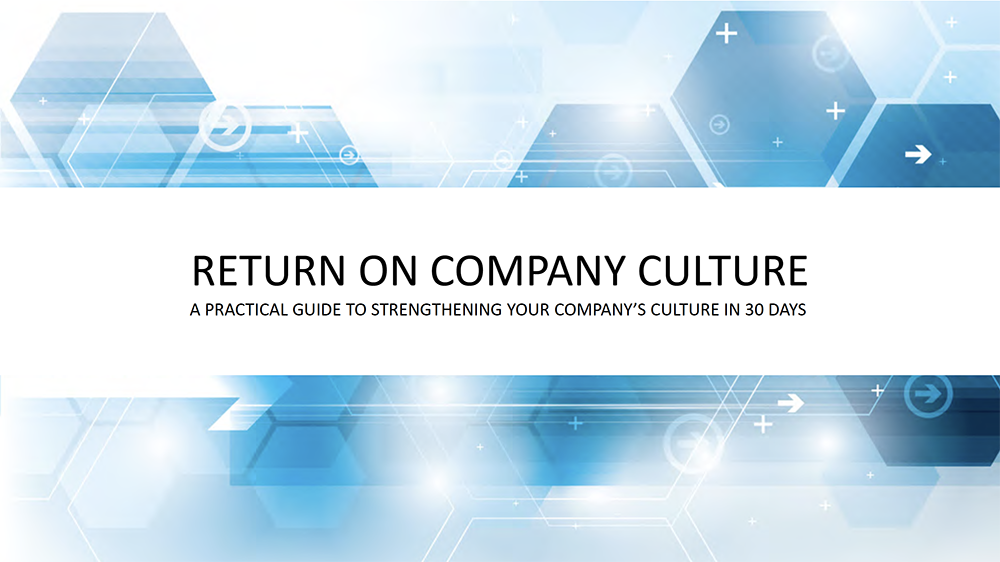
About the author
William Lindstrom found his career niche in helping organizations achieve their business and financial objectives through technology and analytics. Read More
-
William Lindstromhttps://www.theculturethinktank.com/author/wlindstrom/August 10, 2021
-
William Lindstromhttps://www.theculturethinktank.com/author/wlindstrom/July 14, 2021
-
William Lindstromhttps://www.theculturethinktank.com/author/wlindstrom/June 1, 2021
-
William Lindstromhttps://www.theculturethinktank.com/author/wlindstrom/April 8, 2021









